In the early nineteenth century, Trịnh Hoài Đức, a Vietnamese scholar-official of Chinese descent, compiled a geographical gazetteer of the Mekong Delta region entitled the Comprehensive Gazetteer of Gia Định Citadel (Gia Định thành thông chí 嘉定城通志).
In 1863, Gabriel Aubaret, a French Naval officer who knew Chinese, published a translation of this work as The History and Description of Lower Cochinchina (Country of Gia-dinh) (Histoire et description de la Basse Cochinchine [pays de Gia-dinh]).
Trịnh Hoài Đức compiled his text not long after the Nguyễn Dynasty had consolidated its control over the Mekong Delta region, and Gabriel Aubaret produced his translation as the French were gaining control over the area around Gia Định.
As such, both of these men were the first to produce knowledge about this region for their respective readers/governments. In reading what they wrote, it is fascinating to see the way in which each man’s worldview influenced how he wrote or translated.
Educated on classical (Chinese) texts, Trịnh Hoài Đức viewed and described the region in East Asian geomantic terms (what we now call phong thủy/fengshui). Unfamiliar with that worldview, Aubaret unwittingly omitted the geomantic information in Trịnh Hoài Đức’s text in his translation, and reorganized the text so that the information could be presented in a way that was more comprehensible to European readers. By doing this, Aubaret made it impossible for readers of his translation to access Trịnh Hoài Đức’s ideas.
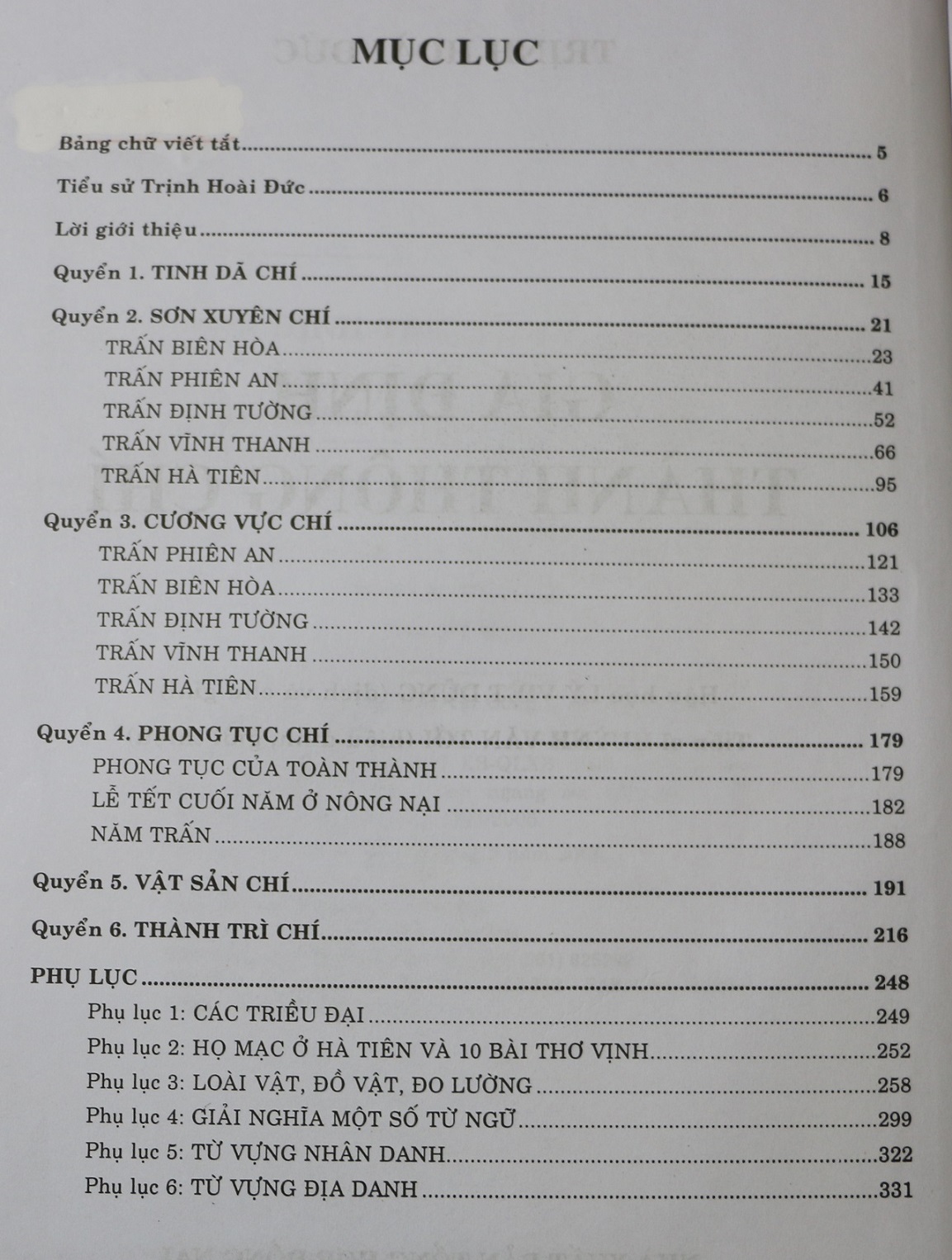
Trịnh Hoài Đức’s text is divided into the following six chapters:
Astronomical divisions (Tinh dã chí 星野志)
Mountains and rivers (Sơn xuyên chí 山川志)
Territorial boundaries (cương vực chí 疆域志)
Customs (Phong tục chí 風俗志)
Local products (Vật sản chí物產志)
Citadels and moats (Thành trì chí 城池志)
These categories can all be found in countless Chinese geographical gazetteers as they reflected a widely held belief in premodern East Asia about how the world was structured and functioned, an idea that Trịnh Hoài Đức references in the opening words of his book:
“Heaven beautifies stars above, Earth elevates mountains below, and people engender refinement in between. As the three powers [i.e., Heaven, Earth and Man] circulate, objects are transformed.”
夫天麗星於上,地峙山於下,人毓秀其中。三才流通而物化成矣。
This is a view of the world that has its intellectual roots in ancient texts like the Classic of Changes (Yijing 易經) and which was elaborated on countless times over the course of two millennia. The basic point is that Heaven, Earth and Man are intimately connected. That is why Trịnh Hoài Đức felt that it was essential to understand the “astronomical divisions” in Heaven and the “mountains and rivers” and “territorial boundaries” on Earth because he believed that the “customs” and “local products” in the lives of Men were engendered through the circulation of primordial energy between these realms.
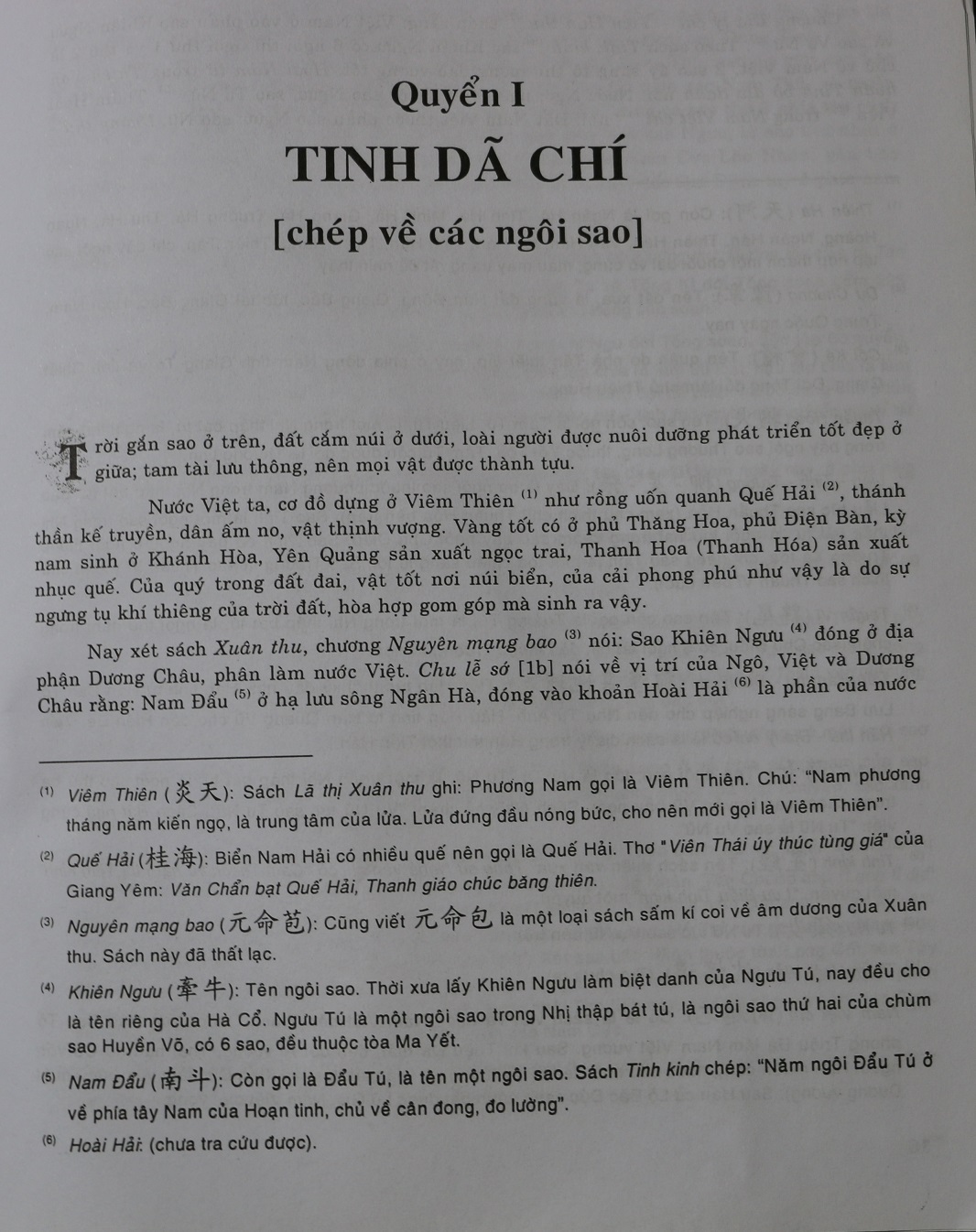
How did Trịnh Hoài Đức attempt to learn about “astronomical divisions” or “mountains and rivers”? He did this by first consulting ancient Chinese texts. While Trịnh Hoài Đức found sufficient about astronomical divisions information in texts like the Spring and Autumn Annals (Chunqiu 春秋) and the History of the Former Han (Qian Hanshu 前漢書), he had a more difficult time finding information about the mountains and rivers of the Mekong Delta region in ancient Chinese texts.
He begins his chapter on mountains and rivers (Sơn xuyên chí 山川志) by again referencing the fundamental East Asian idea of the interconnectedness of the “three powers,” and in this case he highlights the relationship between Earth and Man. To quote, Trịnh Hoài Đức writes that,
“Mountains [sơn 山] are the earth’s bones and rivers [thủy 水 or xuyên 川] are the earth’s blood. With gestation they produced this piece of land. Its heroes, worthies, loyal officials and virtuous women all then appeared, precious items emerged and articles of value grew.”
山為地之骨,水[or 川]為地之血,孕毓流通,以成就此一方土地。其英雄豪傑忠臣烈女亦於是乎出,而寳藏興焉貨財殖焉。
The opening statement here echoes a line in Wang Chong’s first-century Balanced Discourses (Lunheng 論衡), one of the earliest philosophical texts to contain information about the natural world and its relationship to the world of men. What made mountains and rivers similar to human bodies is that they had energy coursing through their “veins” or “sinews,” and that energy could engender “heroes, worthies, loyal officials and virtuous women” (anh hùng, hào kiệt, trung thần, liệt nữ), ideal types of people in the East Asian/Confucian worldview.
This is where the theory of the “three powers” intersects with the philosophical ideas behind geomancy, and Trịnh Hoài Đức was well aware that geomantic energy was not equally distributed across the land. Instead, it coursed through “arteries” (mạch 脈) that were strong in some places and weak in others.
In researching and writing his book, Trịnh Hoài Đức sought to identify and document the presence of that geomantic energy in the Mekong Delta Region.
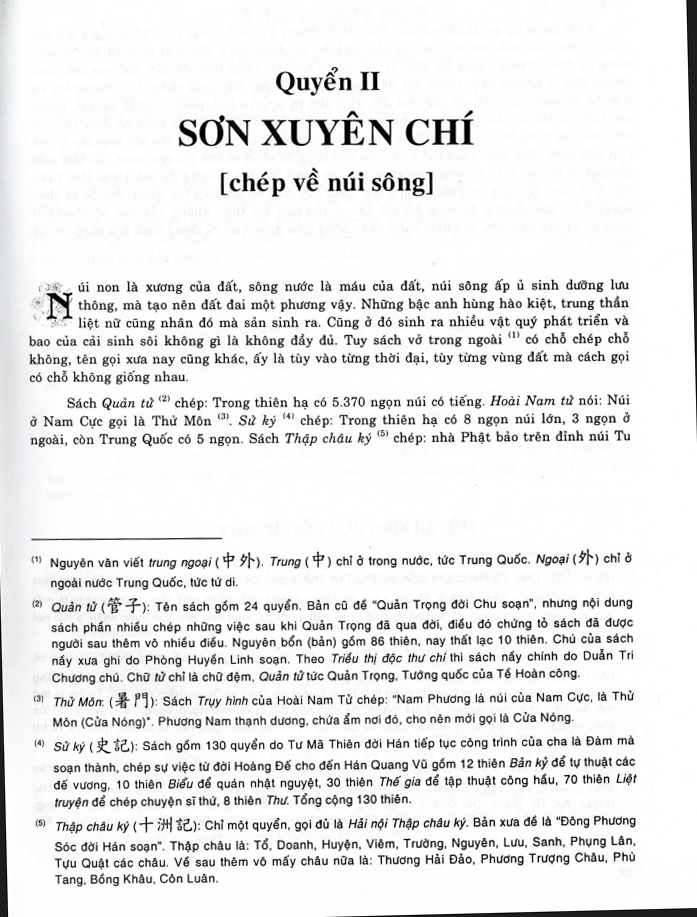
To do so, Trịnh Hoài Đức looked at what had been written in ancient Chinese texts, starting first with works acceptable to Confucian scholars and then discussing what Buddhists had said and finally looking at more recent writings on geomancy.
To quote, he stated about mountains that,
“The Guanzi states that ‘In All Under Heaven there are 5,370 famous mountains.’ The Huainanzi states that ‘Extreme South Mountain is called Summer Heat Gate.’ The Historical Records [Shiji] states that ‘In All Under Heaven there are three famous mountains; three are outside and five are inside the Middle Kingdom.’ The Records of Ten Islands [Shizhou ji] states that ‘Shakya[muni] refers to Mount Sumeru, which has four peaks that rise up, each 700 fathoms high, and each governs over a continent. The southern continent is called Jambudvīpa.’ A text on geomantic principles [The Complete Book of Mountain Techniques, Shanfa quanshu] states that ‘A “great ancestor” is the highest mountain, and is the progenitor of a region’s [geomantic] artery, and is what the various dragon [veins] all follow.’”
管子曰,天下名山,五千三百七十。淮南子曰,南極之山,曰暑門。史記曰,天下名山八,三在外,五在中國。十洲記曰,釋氏謂須彌山頂,四峰拔出,各高七百仞,每峰各主一方,天下南天下曰閻浮提。地理書曰,太祖者最高之山,為一方發跡[should be 脈]之祖,群龍之所從出[should be 者是]也。
Trịnh Hoài Đức then cited the following works for philosophical ideas about the role of water:
“The Record of the Mysterious Center [Xuanzhong ji] states that, ‘That which is abundant in All Under Heaven is water. It holds up Heaven and carries the earth. Whether high or low, there is no place that it does not reach, and no object that it does not moisten.’ The Disquisition on the Principles of Things [Wuli lun] states, ‘That which establishes Heaven and Earth is water. Water is therefore the basis of Heaven and Earth. The emanation of primordial energy, the radiation of the sun and the moon, and the movement of asterisms are all enabled by water. Beyond the Nine Regions [i.e., the ‘heartland’ of the Middle Kingdom], it is all water.’”
元[should be 玄]中記曰,天下之多者水也,浮天載地,高下無所不至,萬物無所不潤。物理論曰,所以立天地者,水也。夫水者,天地之本也。吐元氣,發日月,經星辰,皆由水而興。九州之外皆水也。
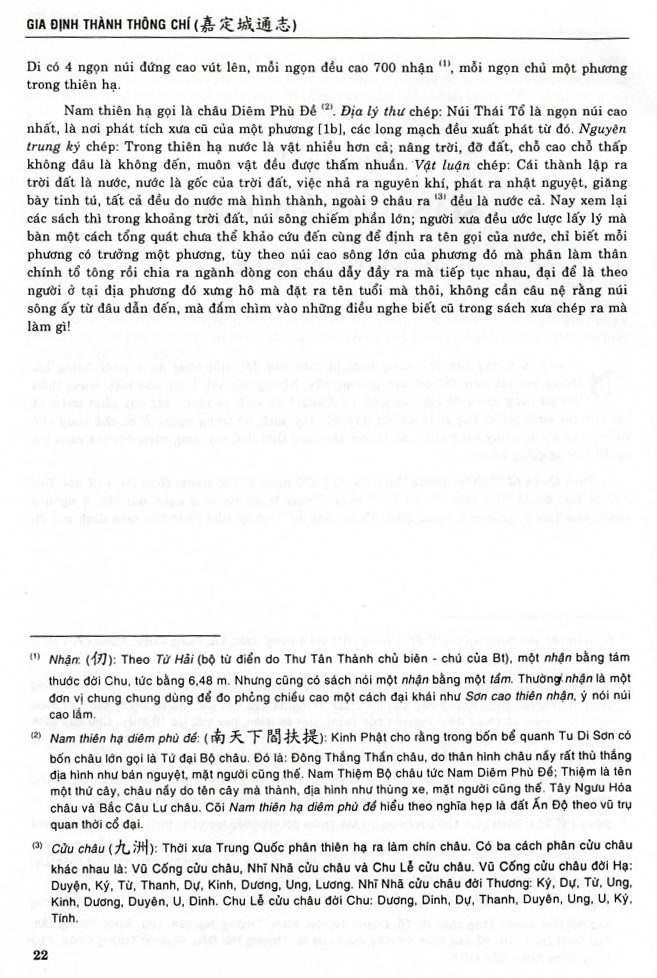
This information was not helpful for understanding the mountains and rivers of the Mekong Delta. This is because ancient Chinese scholars wrote about what was “inside” (trung 中) the known world of the Middle Kingdom. They did not know about what was “outside” (ngoại 外) that world, and only left brief and vague comments about.
The Mekong Delta was far “outside” the ancient heartland of the Middle Kingdom. Trịnh Hoài Đức therefore could not rely on ancient Chinese texts to write about the mountains and rivers of the Mekong Delta.
The solution he came up with was to put aside ancient books and to try understand the region based on the ideas of the East Asian geomantic tradition.
To quote, Trịnh Hoài Đức stated that,
“From these books [we can see that] there are many mountains and rivers between Heaven and Earth, and the ancients roughly mapped them out and spoke in general terms about them. However, we cannot investigate and determine their names. We just know that in a given region there is a region’s [area of] strength, the place where there are famous mountains and big rivers that serve as an ancestral orthodox stem that then divides into descendent lines that extend and continue it. These are all generally named by local people so there is no need to fixate on the origins [of names] and to sink into the outdated information of ancient texts. Indeed!”
按群書,天地間山水甚多,古人皆約略以理,而括言之,不能窮究以指定其名號。是知一方者,自有一方之長,各隨所在之名山大川,以爲祖宗正幹,而分子孫支派,旁羅以接續之。大率都從所在之人稱呼者以名目之耳,不必抅泥其所從來,而溺于古書記載之舊聞者,斯可矣。
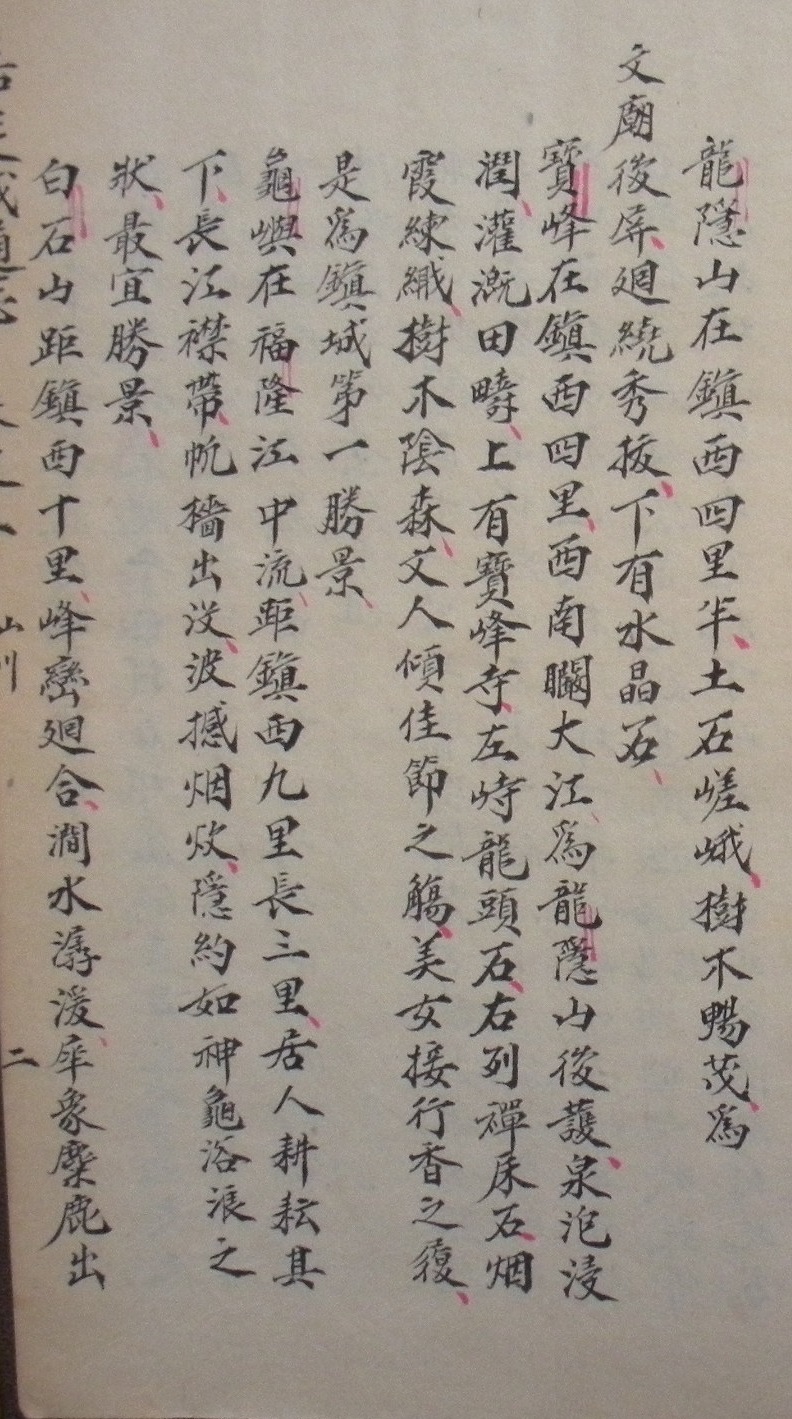
So Trịnh Hoài Đức believed that it would be possible to rely on local knowledge to be able to figure out what local mountains and rivers were named, which ones were famous and big, and from that to be able to understand where a geomantic stem was and where its descendent lines extended to.
The first mountain he discusses is one in Biên Hòa called Mount Long Ẩn (Long Ẩn sơn 龍隱山). This name can be translated as “Dragon Concealing Mountain.” The passage about this mountain says that “it serves as a rear shield for the Temple of Literature, elegantly winding around it (為文廟後屏,廻繞秀拔).”
While the Temple of Literature (Văn Miếu) in Hanoi is well known, there is also a Temple of Literature in Biên Hòa. According to Trịnh Hoài Đức, the temple at that time was “shielded” (bình 屏) by the Dragon Concealing Mountain.

That name, meanwhile, is loaded with meaning, and can be understood in a couple of ways (although they are related). A concealed dragon could be a reference to a potential emperor, and surely the scholars who visited the Temple of Literature had such aspirations, or at least aspired to be near to the emperor.
It could also be a reference to the geomantic power in the mountain, but such power was precisely the type of power that could produce an emperor, etc.
Hence, the fact that there was a Temple of Literature that was “shielded” from behind by a “concealed dragon” was significant to Trịnh Hoài Đức as all of this had meaning in the East Asian intellectual world that he lived in.
And while Trịnh Hoài Đức did occasionally note vernacular names for various places in his book (such as noting that Divine Tortoise Mountain, Thần Quy sơn 神龜山, was colloquially known as Turtle Mountain, Núi Ba Ba), it is with these East Asian/Sinitic geomantic terms and ideas that he described the Mekong Delta.
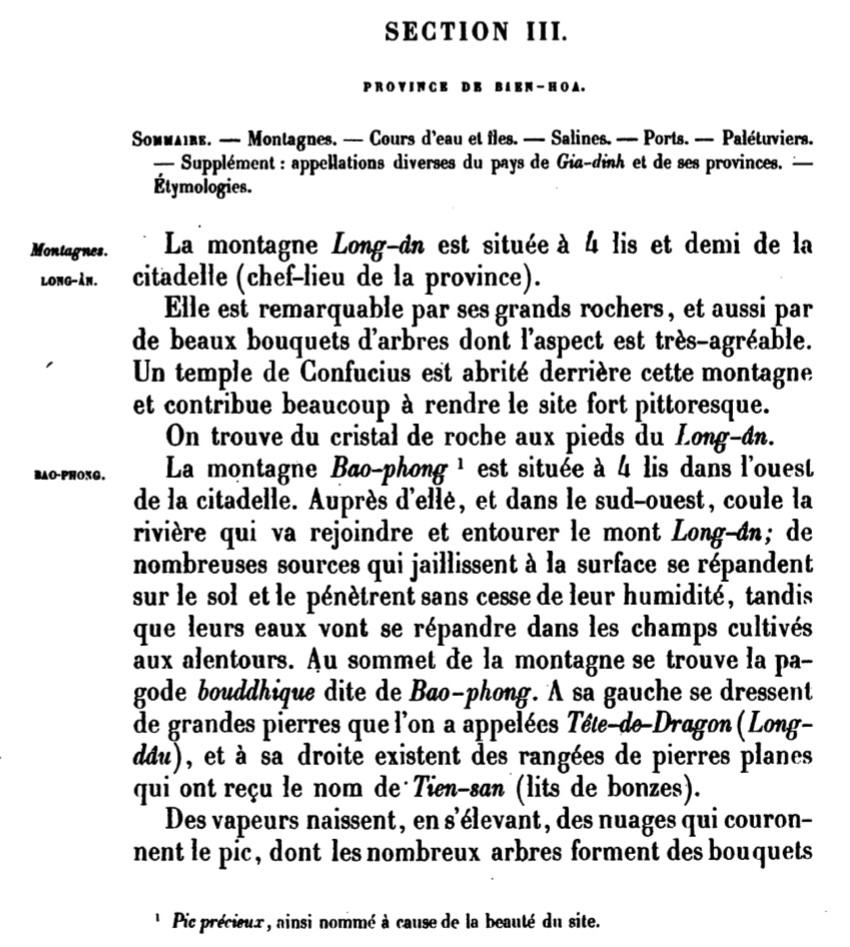
And it is precisely these kinds of ideas that Gabriel Aubaret did not capture in his 1863 translation of Trịnh Hoài Đức’s text. In writing about Dragon Concealing Mountain, for instance, Aubaret left the name untranslated, as Long-ân, so readers would not be able to detect the significance of that name.
In writing about the role that the mountain played in shielding the Temple of Literature, Aubaret wrote that “A temple of Confucius is sheltered behind this mountain and contributes a lot to make the site very picturesque.”
Lovely! That sounds like a wonderful future tourist site, but it is impossible to detect any of the East Asian geomantic ideas that are in Trịnh Hoài Đức’s text and which, as his comments make clear, played a central role in his writing of this book.
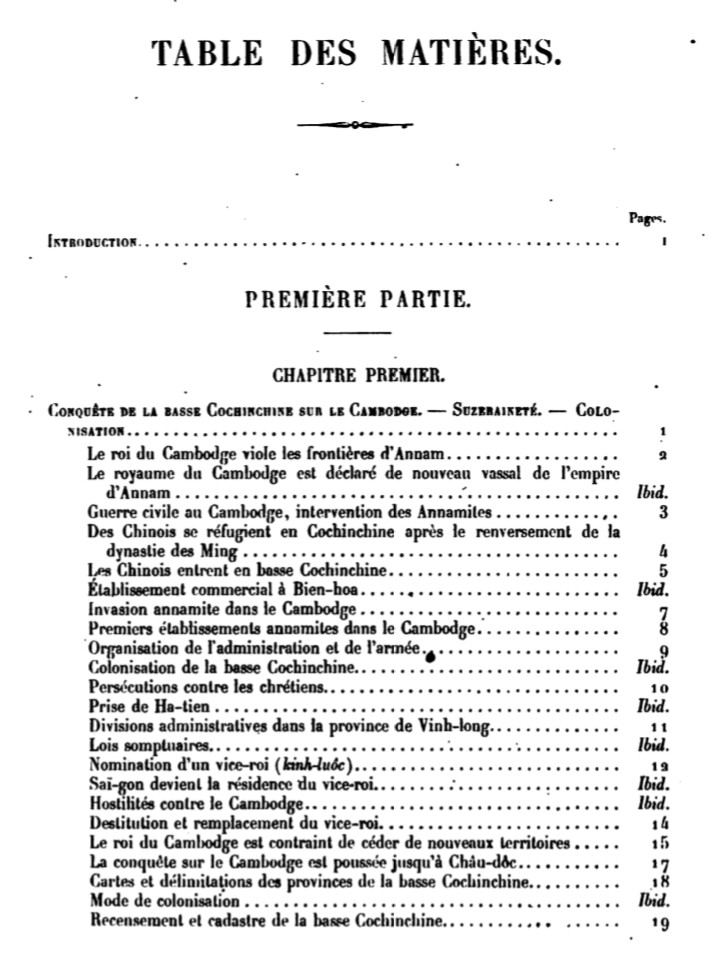
Another way in which Aubaret made it impossible to understand what Trịnh Hoài Đức sought to achieve in his book was by completely re-arranging the text.
For instance, Aubaret’s first three chapters are:
“The Conquest of Lower Cochinchina by Cambodia – Suzerainty – Colonization”
“The Conquest of Hà Tiên – War with Siam”
“The Tây Sơn Revolt”
No such chapters exist in Trịnh Hoài Đức’s book. Yes, he has some historical information on history in the chapter on “territorial boundaries,” so Aubaret did not invent this information, but he did invent the format of the book, and in so doing he made it impossible for readers to understand the ways in which the format of Trịnh Hoài Đức’s book fit perfectly into the East Asian local gazetteer (địa phương chí/difang zhi 地方志) tradition.
In other words, Aubaret did not translate an East Asian local gazetteer. Instead, he created a “French book” based on information that he found in an East Asian local gazetteer.
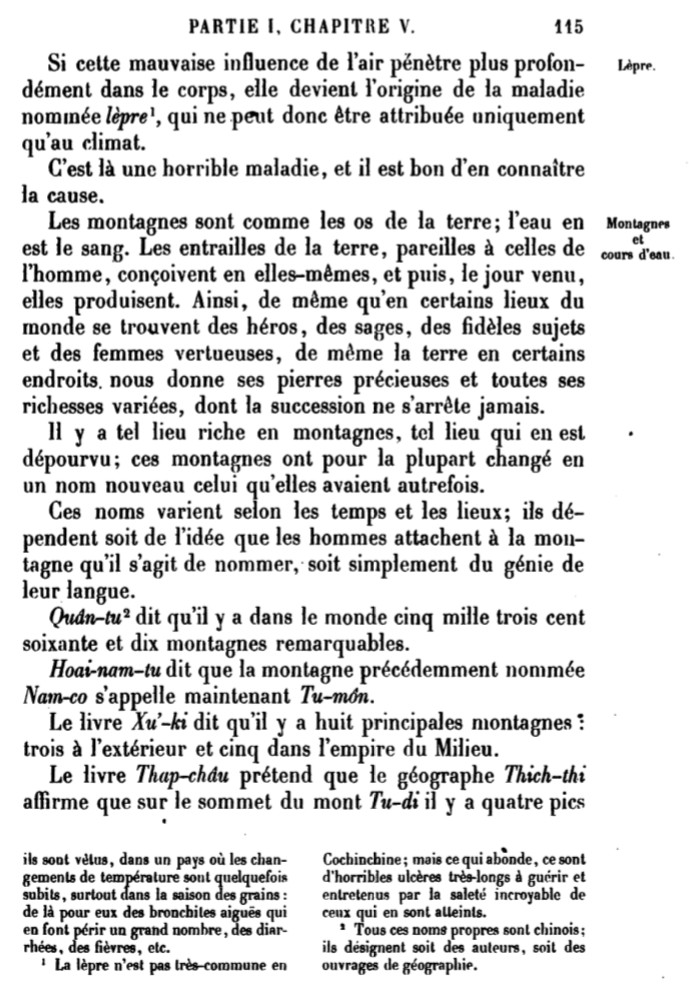
To return to the passage that we examined in detail above where Trịnh Hoài Đức mentions what various ancient texts recorded about mountains and rivers, Aubaret took that introductory information for the chapter on mountains and rivers and placed it at the end of a chapter that Aubaret created on the “Geographical System and Climate” (Système géographique et climat).
Again, there is no such chapter in Trịnh Hoài Đức’s book and the concept of a “geographical system” did not exist in Vietnam or East Asia at that time. More importantly, however, having taken that passage out of its context, a reader can’t see how it was meant to introduce the reader to what Trịnh Hoài Đức wanted to understand about the mountains and rivers in the Mekong Delta.
A reader also can’t see what it is that Trịnh Hoài Đức thought and wanted to do because this passage contains translation mistakes and because Aubaret had no idea what any of the books that Trịnh Hoài Đức referred to were (such as the Huainanzi or Sima Qian’s Historical Records). He simply stated in a footnote that “All of these proper names are Chinese; they designate either authors or geography books.”
Wow!! I wish I could do that. “Yea, this author is just talking about some Chinese stuff here. . . Don’t worry about it. Just keep reading. It’s not important. . .”
Finally, In addition to the fact that Aubaret renders titles in ways that make it impossible to identify some of them even for people who can read classical Chinese and Vietnamese, he also has the “Shakya” in “Shakyamuni” as the name of a geography book, a dragon inhabiting a mountain. . . etc. In other words, Aubaret takes us off into La La Land.
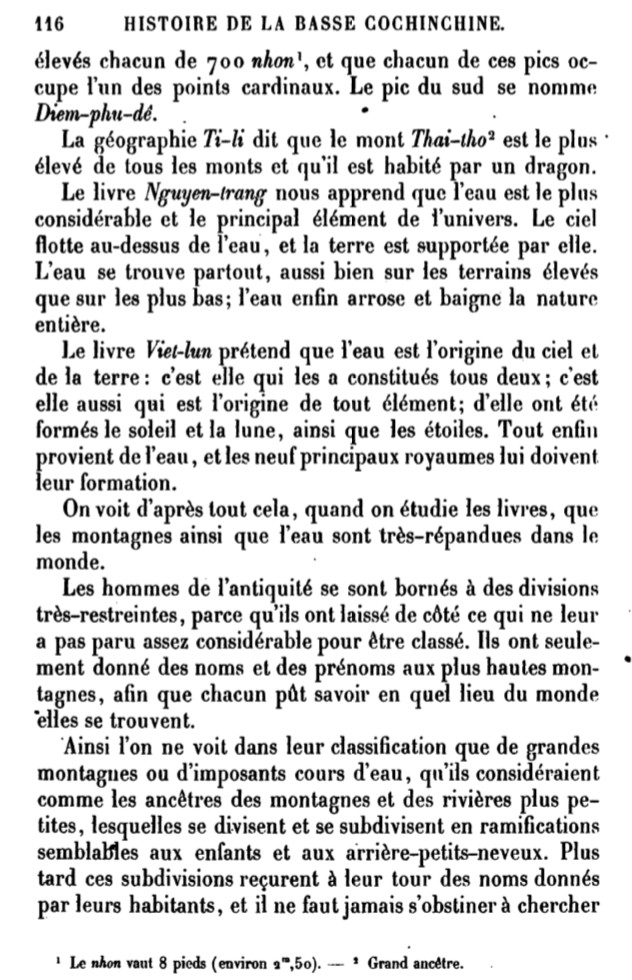
To be fair, in 1863 Aubaret did not need to know about the East Asian philosophical foundations of Trịnh Hoài Đức’s worldview. He just needed basic information about a region that the French had recently conquered so that it could be more easily controlled, and he needed that information fast.
However, for anyone today who does wish to know about how someone like Trịnh Hoài Đức thought about the world he lived in, or for anyone today who wishes to cite Trịnh Hoài Đức’s text to make a statement about Vietnamese culture or history, it’s important to realize that Aubaret’s translation can’t help us with that.
But of course we all know that, so I guess there’s no need to mention any of this. . .

